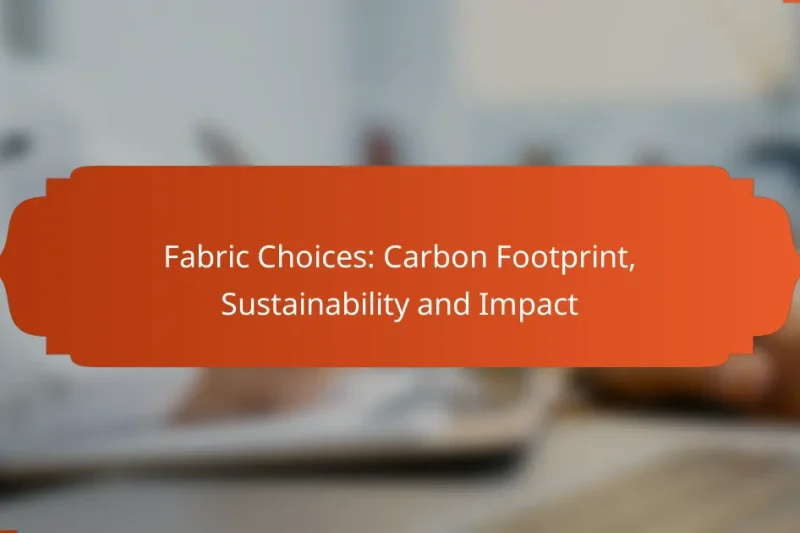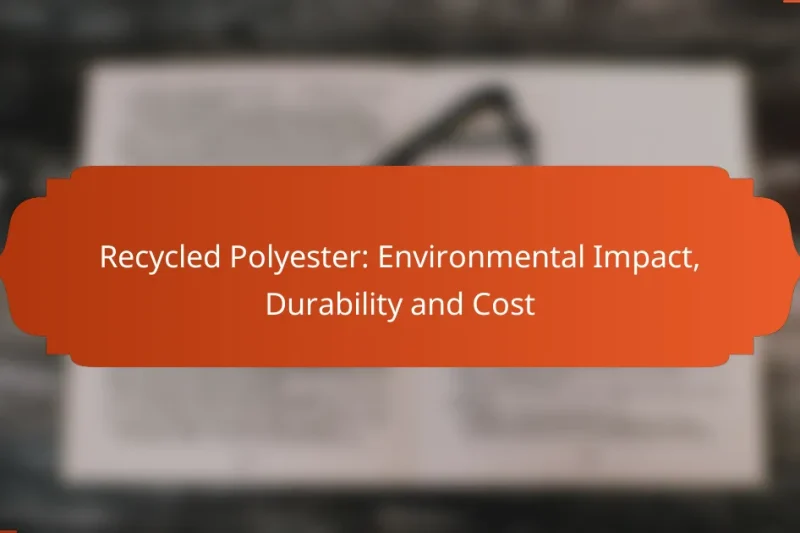Certifications are essential in e-commerce, as they enhance product trustworthiness by assuring consumers of quality, safety, … Certifications: Standards, Labels and TrustworthinessRead more
Sustainable Clothing Materials
Sustainable clothing materials, such as organic cotton, Tencel, hemp, recycled polyester, and bamboo fabric, are designed to minimize environmental impact while promoting renewability and biodegradability. By utilizing these materials, the fashion industry can significantly reduce resource depletion and pollution, fostering a more balanced ecosystem. Choosing sustainable options not only benefits the planet but also supports ethical production practices and enhances consumer safety.
Fabric Choices: Carbon Footprint, Sustainability and Impact
When it comes to fabric choices, understanding their environmental impact is crucial for promoting sustainability. Materials … Fabric Choices: Carbon Footprint, Sustainability and ImpactRead more
Tencel vs. Bamboo: Which Is Better and When to Use
When comparing Tencel and bamboo fabrics, it’s essential to consider their unique properties and environmental impacts. … Tencel vs. Bamboo: Which Is Better and When to UseRead more
Organic Cotton: Benefits, Sustainability and Quality
Organic cotton is a sustainable and eco-friendly alternative to conventional cotton, offering numerous benefits for both … Organic Cotton: Benefits, Sustainability and QualityRead more
Recycled Polyester: Environmental Impact, Durability and Cost
Recycled polyester is an eco-friendly alternative that significantly reduces environmental impact by repurposing plastic waste, thereby … Recycled Polyester: Environmental Impact, Durability and CostRead more
Vegan Leather Alternatives: Materials, Benefits and Ethical Considerations
Vegan leather alternatives provide a sustainable and ethical choice for consumers looking to reduce their environmental … Vegan Leather Alternatives: Materials, Benefits and Ethical ConsiderationsRead more
Hemp Fabric: Sustainability, Breathability and Versatility
Hemp fabric stands out for its sustainability, requiring minimal resources during cultivation and processing while positively … Hemp Fabric: Sustainability, Breathability and VersatilityRead more
What are the best sustainable clothing materials?
The best sustainable clothing materials include organic cotton, Tencel, hemp, recycled polyester, and bamboo fabric. These materials are chosen for their lower environmental impact, renewability, and potential for recycling or biodegradability.
Organic cotton
Organic cotton is grown without synthetic pesticides or fertilizers, making it a more environmentally friendly option compared to conventional cotton. It typically requires less water and promotes biodiversity in farming practices.
When purchasing organic cotton clothing, look for certifications such as GOTS (Global Organic Textile Standard) to ensure that the fabric meets strict environmental and social criteria. This can help you avoid products that may still use harmful chemicals in processing.
Tencel (Lyocell)
Tencel, also known as Lyocell, is made from sustainably sourced wood pulp, often from eucalyptus trees. The production process uses a closed-loop system that recycles water and solvents, minimizing waste and pollution.
This fabric is soft, breathable, and biodegradable, making it a great choice for eco-conscious consumers. Tencel is often blended with other fibers to enhance its durability and comfort in clothing.
Hemp
Hemp is a highly sustainable crop that grows quickly and requires minimal water and pesticides. Its fibers are strong and durable, making hemp clothing long-lasting and resistant to wear.
In addition to its environmental benefits, hemp fabric is breathable and has natural antibacterial properties. Look for clothing made from 100% hemp or blends with other sustainable fibers for optimal comfort and performance.
Recycled polyester
Recycled polyester is made from post-consumer plastic bottles and other plastic waste, significantly reducing the need for virgin petroleum resources. This material helps divert plastic from landfills and oceans while reducing energy consumption during production.
When choosing recycled polyester clothing, check for certifications like the Global Recycled Standard (GRS) to ensure the material is genuinely recycled and produced sustainably. This can help you support brands committed to reducing plastic waste.
Bamboo fabric
Bamboo fabric is derived from the pulp of the bamboo plant, which grows rapidly and requires little water. It is soft, breathable, and has natural antibacterial properties, making it a popular choice for activewear and undergarments.
However, be cautious of the manufacturing process, as some bamboo fabrics are treated with chemicals that can negate their eco-friendly benefits. Look for brands that use a closed-loop process or certifications to ensure a more sustainable product.
How do sustainable materials impact the environment?
Sustainable materials significantly reduce environmental harm by minimizing resource depletion and pollution. They often utilize renewable resources, leading to a more balanced ecosystem and lower ecological footprints.
Reduced carbon footprint
Sustainable clothing materials typically have a lower carbon footprint compared to conventional fabrics. For instance, organic cotton and hemp require less energy to produce, which translates to fewer greenhouse gas emissions. Choosing these materials can help consumers contribute to climate change mitigation.
When selecting sustainable options, look for certifications like Global Organic Textile Standard (GOTS) or OEKO-TEX, which indicate lower carbon emissions in production. This can guide purchasing decisions towards brands that prioritize eco-friendly practices.
Lower water usage
The production of sustainable materials often involves significantly less water than traditional textiles. For example, organic cotton can use up to 90% less water compared to conventional cotton farming. This reduction is crucial in regions facing water scarcity.
To make a positive impact, consumers can choose brands that utilize rain-fed crops or innovative water-saving technologies. Additionally, opting for materials like Tencel, which is derived from sustainably sourced wood pulp, can further minimize water consumption.
Less chemical pollution
Sustainable clothing materials are generally produced with fewer harmful chemicals, reducing pollution in water systems. Conventional textile production often involves toxic dyes and pesticides, which can contaminate local waterways and harm ecosystems. In contrast, sustainable practices prioritize natural dyes and organic farming methods.
When shopping, look for labels that indicate the absence of harmful substances, such as GOTS or bluesign certifications. This ensures that the clothing you purchase supports safer production methods and protects both the environment and human health.
What are the benefits of using sustainable clothing materials?
Using sustainable clothing materials offers numerous advantages, including reduced environmental impact and improved social responsibility. These materials often last longer, are safer for consumers, and support ethical production practices.
Durability
Sustainable clothing materials are typically designed to be more durable than conventional fabrics. This means they can withstand wear and tear, leading to longer-lasting garments that do not need to be replaced as frequently. For example, organic cotton and recycled polyester are known for their strength and longevity.
Investing in durable clothing can save money over time, as consumers will spend less on replacements. Look for certifications that indicate higher durability standards, such as OEKO-TEX or GOTS.
Healthier for consumers
Sustainable clothing materials are often free from harmful chemicals and toxins that can be present in conventional textiles. Fabrics made from organic fibers, such as organic cotton or bamboo, are less likely to cause skin irritations and allergies. This is particularly important for sensitive skin or for children.
Additionally, many sustainable materials are produced using eco-friendly dyes and processes, which can further reduce health risks. Consumers should seek out brands that prioritize transparency in their production methods and materials.
Ethical production practices
Sustainable clothing materials are often associated with ethical production practices that prioritize fair labor conditions and environmental stewardship. Brands that use these materials typically ensure that workers are paid fair wages and work in safe environments. This contrasts with fast fashion, where labor exploitation is common.
When choosing sustainable clothing, look for certifications like Fair Trade or WRAP, which indicate adherence to ethical labor standards. Supporting these brands not only promotes better working conditions but also contributes to a more sustainable fashion industry overall.
How to choose sustainable clothing materials?
Choosing sustainable clothing materials involves assessing their environmental impact, sourcing practices, and certifications. Focus on materials that minimize harm to the planet while ensuring ethical production processes.
Consider certifications
Certifications can help identify sustainable clothing materials. Look for labels such as Global Organic Textile Standard (GOTS), OEKO-TEX, and Fair Trade, which indicate adherence to specific environmental and social standards.
These certifications often require transparency in the supply chain, ensuring that the materials are produced without harmful chemicals and under fair labor conditions. Checking for these labels can simplify your decision-making process.
Evaluate sourcing practices
Assessing sourcing practices is crucial for understanding the sustainability of clothing materials. Investigate whether the materials are sourced locally or internationally, as local sourcing typically reduces transportation emissions.
Additionally, consider whether the materials are derived from renewable resources, such as organic cotton or hemp, which have a lower environmental footprint compared to conventional materials. Brands that prioritize eco-friendly sourcing often share their practices on their websites.
Analyze lifecycle impacts
Analyzing the lifecycle impacts of clothing materials involves looking at their environmental effects from production to disposal. Consider factors such as water usage, energy consumption, and waste generation throughout the material’s life cycle.
For example, synthetic fibers like polyester may require significant energy and water during production, while natural fibers can be biodegradable but may need pesticides and fertilizers. Understanding these impacts can guide you toward more sustainable choices.
What are the leading brands using sustainable materials?
Several prominent brands are recognized for their commitment to sustainable clothing materials, focusing on eco-friendly practices and ethical sourcing. These brands prioritize reducing environmental impact while maintaining quality and style.
Patagonia
Patagonia is a pioneer in sustainable clothing, known for its use of recycled materials and organic cotton. The brand emphasizes transparency in its supply chain and actively supports environmental initiatives.
Key materials used by Patagonia include recycled polyester and organic wool, which help minimize the ecological footprint of their products. The company also encourages customers to repair and recycle their gear, promoting a circular economy.
When shopping for sustainable clothing, consider Patagonia’s Fair Trade Certified options, which ensure fair wages and safe working conditions for workers. This commitment not only supports ethical labor practices but also enhances the overall sustainability of their products.






